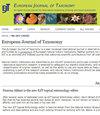New details of the enigmatic 100 million years old antlion-like larvae of Ankyloleon (Myrmeleontiformia, Neuroptera)
IF 1.3
3区 生物学
Q3 ENTOMOLOGY
引用次数: 0
Abstract
Lacewing larvae in the Cretaceous were more diverse in appearance than they are today, best documented by numerous fossils preserved in amber. One morphotype of an unusual larva from about 100 Ma old Kachin amber (Myanmar) was formally recognised as a distinct group called Ankyloleon. The original description erected a single formal species, Ankyloleon caudatus. Yet, it was indicated that among the five original specimens, more species were represented. We here report five new specimens. Among these is the so far largest as well as the so far smallest specimen. Based on this expanded material we can estimate certain aspects of the ontogenetic sequence and are able to recognise a second discrete species, Ankyloleon caroluspetrus sp. nov. We discuss aspects of the biology of Ankyloleon based on newly observed details such as serrations on the mandibles. Long and slender mouthparts, legs and body together with a weakly expressed outer trunk segmentation provide indications for a lifestyle hunting for prey in more confined spaces. Still many aspects of the biology of these larvae must remain unclear due to a lack of a well comparable modern counterpart, emphasising how different the fauna of the Cretaceous was.1亿年前神秘的蚁龙类幼虫(蚁龙目,神经龙科)的新细节
白垩纪的草蜻蛉幼虫比今天的草蜻蛉幼虫外形更加多样,保存在琥珀中的大量化石就是最好的证明。在距今约 100 马年的克钦邦(缅甸)琥珀中,一种不寻常的幼虫形态被正式确认为一个独特的类群,称为 Ankyloleon。最初的描述只建立了一个正式的物种,即 Ankyloleon caudatus。然而,有研究表明,在五件原始标本中,代表了更多的物种。我们在此报告五个新标本。其中既有迄今为止最大的标本,也有迄今为止最小的标本。根据这些扩大的材料,我们可以估计其本体发生序列的某些方面,并能够确认第二个独立的物种,即 Ankyloleon caroluspetrus sp.我们根据新观察到的细节(如下颚上的锯齿)讨论了 Ankyloleon 的生物学方面。细长的口器、腿和身体以及微弱的躯干外节,表明它们的生活方式是在更狭窄的空间中捕食猎物。由于缺乏可很好比较的现代对应物,这些幼虫的生物学的许多方面仍然不清楚,这突出了白垩纪动物群的不同。
本文章由计算机程序翻译,如有差异,请以英文原文为准。
求助全文
约1分钟内获得全文
求助全文
来源期刊

European journal of taxonomy
ZOOLOGY-
CiteScore
2.30
自引率
8.30%
发文量
173
审稿时长
29 weeks
期刊介绍:
EJT is a fully refereed, international, fully electronic Open Access journal in descriptive taxonomy, covering subjects in zoology, entomology, botany (in its broadest sense), and palaeontology. EJT-papers must be original and adhere to high scientific (content) and technical (language, artwork, etc.) standards. Manuscripts that are clearly substandard in either of these categories will not be sent out for review. EJT is supported by a consortium of European Natural History Institutes, but its scope is global. Both authorship and geographical region of study need not be European. Authors are, however, strongly encouraged to involve European Natural History collections by consulting material or by depositing specimens (e.g. types and figured material) related to their published paper in the collection of a European Natural History Institute.
 求助内容:
求助内容: 应助结果提醒方式:
应助结果提醒方式:


